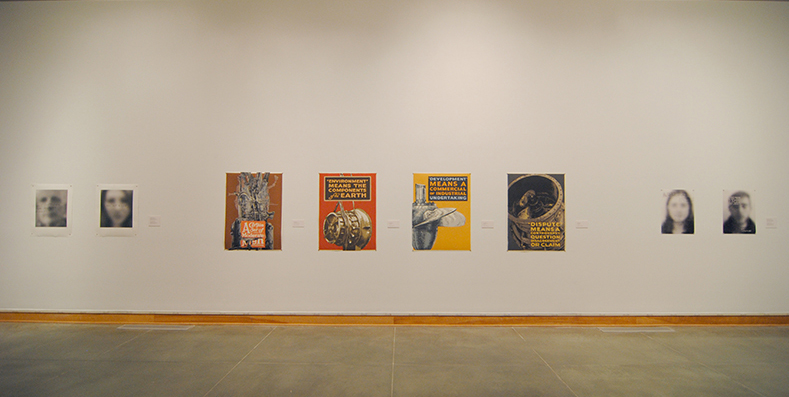
Photo from the 2018 Okanagan Print Triennial at the Kelowna Art Gallery
Briar Craig, a full professor teaching printmaking in the BFA program here at UBC Okanagan has been organizing international printmaking exhibitions since he started here in early 1991 (then Okanagan University College). Briar worked with printmaking colleague Mary Smith McCulloch to organize exhibitions of print works from people outside of the local community.
“The initial idea was to bring work here that we would not normally get to see in person,” notes Briar.
Briar and Mary started by organizing a couple of invitational shows inviting Canadian artists to submit work, and then opened it up to include international artists for future years. They would set up the shows in the gallery at the K.L.O. campus with the intention of ramping up to something that resembles what is now The Okanagan Print Triennial (OPT). The university gallery at the K.L.O. campus and at the UBCO campus are just not large enough to host an exhibition of this scope and ambition and it took a number of years to find an Okanagan gallery willing to be a partner for this project. Lubos Culen the curator at the Vernon Public Art Gallery was the first to come on board followed by Liz Wiley at the Kelowna Art Gallery. Without the support of those two galleries the OPT would never have been possible.
Since 2009, the OPT has involved showing the work every three years alternating between the Vernon Public Art Gallery and the Kelowna Art Gallery.
The works submitted for the OPT are juried by Briar and the curators at both galleries. Each year they have submissions from between 75 to 125 artists from around the world. In order to create an exhibition that reflects the current ideas of participating artists, all submitted work needs to have been created in the last 3 years.
“One of the things that distinguishes the OPT from many other international print exhibitions is that we want to show bodies of peoples works rather than just one piece from each participating artist. When seeing small bodies of an artist’s work you start to get a sense of what that artists ideas are.” He also adds, “we like to have about 25 artists each show, but to do that we do need a big space, and space is limited at both of the galleries.”
Many of the works we juried into the exhibition this year were made in 2020. In the midst of a pandemic, our lens for looking at that work ‘was quite flavoured’ by social isolation, he explains. “The work is timely in its content and what it is trying to say.”
This is something that is intrinsic to printmaking, the history of printmaking in general tends to come from advertising and the spreading of information. The printed word created literacy and artists that use printmaking mediums are creating a kind of literacy for their work in a broad sense.
“Artists continue to say things about their lives through their work and an exhibition like the OPT brings that work here for us to see and investigate. We get to see a snapshot of what is happening in South Korea, or Australia or Poland. It is pretty exciting.”
Since McCulloch retired, Briar is now the only print professor, and he says that the students get only one perspective. While his perspective and experience is pretty broad, it is not all encompassing.
“The OPT exhibition is a huge benefit for students in our classes. They get to see world class and contemporary work in person”, he explains. The influence of seeing other people’s work, and seeing the subtleties in those works in person expands what is possible to someone who is just starting out in their art practice.
“It is fun to go through the shows with a class. Everyone gets excited about what they are seeing, and it is so much fun as it sparks curiosity.” He says, “seeing work from other artists can give students ideas on how to express themselves and how to make use of the materials that are unique to printmaking.”
The 2021 Okanagan Print Triennial is scheduled at the Vernon Public Art Gallery from March 18 to May 19 and has 28 printmakers from 15 countries around the world. The jury for this year’s show were Briar Craig, Lubos Cullen Curator for the VPAG, and FCCS professor emeritus and art historian, Carolyn MacHardy. A catalogue will accompany the exhibition, printed with financial support from the Faculty of Creative and Critical Studies.
There are two major awards given every year, a purchase prize, and the top artist prize. The winner of each Triennial is given a solo show at the gallery not hosting the show the third year following. This year we look forward to seeing the work of Ericka Walker who was in the show in 2018 at the Kelowna Art Gallery. Her exhibition, A decaying fort and lack of guidance, opens at the Kelowna Art Gallery on April 10.
For more information on the 2021 OPT, visit: www.vernonpublicartgallery.com/okanagan-print-triennial

Photo from the 2015 Okanagan Print Triennial at the Vernon Public Art Gallery
What is Printmaking?
The umbrella term printmaking involves a number of different methods of creating art works through the process of printing. Typically, a print-artist creates an image, then takes that image and draws it onto a lithographic stone, or etches it with nitric acid into an etching plate or makes a stencil on a silkscreen, and then uses that process to transfer the imagery to another surface – usually paper or fabric.